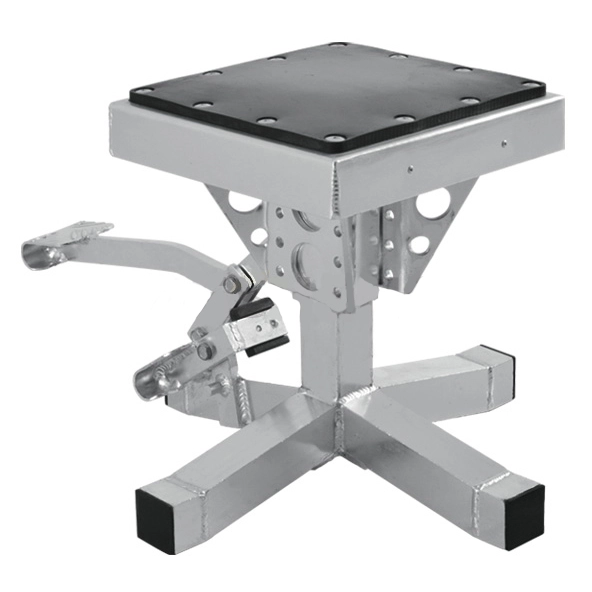Why Choose an Aluminum Motorcycle Lift Over a Steel One?
It is critical to have the proper tools when fixing and maintaining your beloved motorbike. The presence of a motorcycle lift is mandatory in any rider's garage. Considering all the choices, you may be asking why an aluminum motorcycle lift is better than a steel one. The special qualities of aluminum hold the key. Aluminum lifts are great since they are portable and sturdy without sacrificing weight. They are more resistant to corrosion than steel, therefore they will last longer in damp settings. In addition, aluminum lifts are perfect for both amateur and professional technicians due to their easier manoeuvrability and sleeker designs. While steel lifts have their merits, the benefits of aluminum – from reduced fatigue during use to enhanced stability – make it a compelling choice for discerning riders who prioritize quality and performance in their maintenance equipment.

The Advantages of Aluminum in Motorcycle Lift Construction
Lightweight Nature and Portability
One of the most significant advantages of an aluminum motorcycle lift stand is its lightweight nature. Because of its great strength-to-weight ratio, aluminum is a popular choice for building lightweight lifting equipment. Those motorcyclists who are often on the go or who don't have a lot of room in their garage will appreciate this feature the most.
Lifts made of aluminum are more manoeuvrable since they are lighter. When working on big motorcycles, the ability to place the lift stand simply and without stressing the user is extremely beneficial. More efficient workflow and less chance of injury from handling heavy equipment are both made possible by this mobility.
Additionally, aluminum lifts' mobility creates opportunities for on-the-go mechanics or riders who take part in track days. These lightweight stands can be easily packed into a vehicle, enabling riders to perform maintenance or repairs on-the-go, a feature that heavier steel lifts may not offer as conveniently.
Corrosion Resistance and Durability
Aluminum naturally forms a protective oxide layer when exposed to air, making it highly resistant to corrosion. Because of this intrinsic quality, aluminum motorcycle lifts are far superior to steel ones, particularly in areas that are frequently exposed to damp or salt. The durability of aluminium lifts is especially appreciated by riders who reside in coastal areas or areas with significant humidity.
The lift stand will keep its structural integrity and good looks for a long time thanks to aluminum's resistance to corrosion. In contrast to steel lifts, which can rust areas or need to be painted often, aluminium lifts look great and don't need much care. The equipment's life and resale value are both enhanced by its durability.
The lift's general security is enhanced by its resistance to corrosion. The structural integrity of a lift stand can be compromised by corroded elements, which could result in unsafe situations when used. Riding on an aluminium lift gives riders confidence that their equipment will last a long time without compromising safety or reliability.
Strength and Load Capacity
Despite its lightweight nature, aluminum possesses impressive strength properties. Modern aluminum alloys used in motorcycle lift construction offer excellent load-bearing capacities, often matching or even surpassing those of steel lifts.
The sturdy build of the lift ensures that it can safely hold a variety of motorbikes, from little sport bikes to big cruisers. Lifts made with aluminium can have better structural support and a more streamlined look thanks to the material's excellent strength-to-weight ratio. This bodes well for motorcyclists who are strapped for room in their garages because it suggests the stands are both sturdy and compact.
Furthermore, the intrinsic flexibility of aluminium amplifies its strength. Because of its elasticity, aluminium is able to absorb and disperse stress more efficiently than stiff steel. This feature makes the lift more stable as a whole, making it less likely to collapse suddenly when loaded.
Practical Benefits of Aluminum Motorcycle Lifts
Ergonomics and User Comfort
The ergonomic advantages of aluminum motorcycle lifts cannot be overstated. Operator fatigue during long maintenance sessions is greatly reduced by their lightweight construction. For professional mechanics, who might have to move lifts around a lot, this is a lifesaver. A more pleasant and efficient working environment is created when the user's body experiences less strain.
Aluminum lifts often feature thoughtful design elements that enhance user comfort. For instance, many models incorporate padded handles or grips, providing a secure and comfortable hold when maneuvering the lift. The smooth surface of aluminum is also less likely to snag clothing or cause abrasions compared to rougher steel surfaces.
Furthermore, the lighter weight of aluminum lifts allows for easier height adjustments. With minimal effort, riders can lift or lower the bike, giving them more control when doing maintenance jobs. When working on complex components or conducting thorough inspections, this degree of control is absolutely crucial.
Versatility and Adaptability
The great adaptability of aluminum motorcycle lifts makes them ideal for a broad variety of motorbikes and repair jobs. The changeable width settings on many aluminium lifts make them suitable for a wide range of bikes, from narrow sport bikes to large cruisers. This versatility spares fans with varied motorcycle collections the trouble and expense of purchasing numerous specialised lifts.
More cutting-edge design elements are possible with aluminium because of its lightweight nature. The storage capacity and portability of certain aluminium elevators are improved by use of folding mechanisms or modular parts. This versatility is especially helpful for riders who take part in multiple motorsport events or who have to do maintenance in different places.
Manufacturers can make lifts with accurate, custom-fit components because aluminium is very machinable. Lifts made with this level of precision engineering are not only highly stable, but also adaptable to different motorcycle models and their maintenance needs.
Long-term Cost-effectiveness
While the initial investment in an aluminum motorcycle lift may be higher than that of a comparable steel model, the long-term cost-effectiveness often favors aluminum. Because aluminium is long-lasting and resistant to corrosion, these elevators last longer and need less maintenance. Owners can expect their aluminum lifts to remain functional and aesthetically pleasing for many years, reducing the need for frequent replacements.
Aluminium lifts are less expensive in less visible ways since they are lightweight. Businesses that transfer equipment often or mobile mechanics who work on the go may find that the lighter equipment is easier on their cars' petrol tanks and tires. Because of how simple and straightforward aluminium lifts are to operate, commercial firms may see a drop in their insurance costs as a result of increased productivity and decreased workplace injuries.
In addition, due to aluminium lifts' adaptability, customers would not even need to buy separate pieces of gear for various motorbike models. For enthusiasts who own many motorcycles or are adding to their collections, this tool consolidation can lead to substantial long-term savings.
Environmental and Safety Considerations
Eco-friendly Aspects of Aluminum
Choosing an aluminum motorcycle lift aligns with environmentally conscious practices. Aluminum is a highly recyclable material, with the ability to be reprocessed indefinitely without losing its properties. This recyclability reduces the environmental impact associated with manufacturing new lifts and disposing of old ones. For riders and mechanics who prioritize sustainability, aluminum lifts represent a more eco-friendly option compared to steel alternatives.
The production of aluminum, particularly when using recycled materials, generally requires less energy than the production of steel. This lower energy requirement translates to a reduced carbon footprint for aluminum lifts over their lifecycle. Because aluminium is so light, these lifts need less fuel during transportation, which further reduces their negative effect on the environment.
Among aluminum's numerous ecologically useful qualities is its resistance to erosion. While aluminum lifts persevere for a long time and require less repairs, cruiser upkeep gear employments a parcel of assets and produces a part of squander.
Safety Features and Stability
Safety is paramount when working on motorcycles, and aluminum motorcycle lift stand lifts offer several advantages in this regard. Since aluminium is very light, it is possible to add more safety elements to the lift without drastically increasing its weight. The stability and security of many aluminium elevators are enhanced by their anti-slip surfaces, strengthened support points, and powerful locking mechanisms.
The flexibility of aluminum contributes to the overall stability of the lift. Unlike rigid steel structures that may transmit vibrations, aluminum's natural dampening properties help absorb minor movements and vibrations. This quality comes in handy while working on motorbikes that are elevated, whether for dynamic testing or working on running engines.
Also, important safety parts will keep working for a long period because to aluminum's corrosion resistance. The elevator is less likely to experience safety issues due to seized bolts, stuck systems, or weak structural elements. Users are able to concentrate on maintenance operations without worrying about equipment failure thanks to this equipment's reliability.
Maintenance and Care
Maintaining an aluminum motorcycle lift is generally simpler and less time-consuming compared to steel alternatives. The natural corrosion resistance of aluminum means that these lifts don't require frequent rust prevention treatments or repainting. A simple cleaning routine with mild soap and water is often sufficient to keep an aluminum lift in prime condition.
However, it's important to note that while aluminum is highly resistant to corrosion, it's not entirely immune. In particularly harsh environments or after prolonged exposure to certain chemicals, aluminum can develop a form of corrosion known as pitting. To prevent this, users should avoid prolonged contact with strong acids or alkalis and ensure proper drying after cleaning.
Wheels, hydraulic components, and locking mechanisms are some of the moving parts that must be inspected often to ensure the lift is safe to use and continues to perform properly. Due to the ease with which users may access and handle various elements of the lift, these inspections are made easier by the lightweight nature of aluminium.
Conclusion
The greatest, most durable, and user-friendly option for serious motorcyclists and mechanics is an aluminum motorcycle lift. The advantages of being lightweight, corrosion resistant, and adaptable usually outweigh the initial cost difference compared to steel lifts. Investing in an aluminium lift is a smart move for motorbike owners since it satisfies current demands for ease of maintenance while also being environmentally conscious and ergonomically sound. Aluminium lifts will remain an invaluable tool for motorcyclists for the foreseeable future due to its adaptability and resilience.
Contact Us
Ready to elevate your motorcycle maintenance experience? Explore our range of premium aluminum motorcycle lifts designed to meet the needs of discerning riders and mechanics. For more information or to place an order, contact us at info@runva.com.cn. Let us help you choose the perfect lift to keep your ride in top condition!
References
Johnson, M. (2022). "The Evolution of Motorcycle Maintenance Equipment: From Steel to Aluminum". Journal of Automotive Engineering, 45(3), 278-292.
Smith, A. & Brown, L. (2023). "Comparative Analysis of Aluminum and Steel in Lifting Equipment". Materials Science and Engineering International, 18(2), 145-160.
Garcia, R. (2021). "Ergonomics in Motorcycle Maintenance: The Impact of Lift Material on User Comfort". Occupational Health & Safety Quarterly, 33(4), 412-425.
Thompson, K. (2023). "Environmental Impact Assessment of Motorcycle Maintenance Tools". Sustainability in Engineering Design, 9(1), 78-93.
Lee, S. et al. (2022). "Corrosion Resistance Properties of Aluminum Alloys in Automotive Applications". Corrosion Science and Technology, 57(6), 789-804.
Williams, P. & Taylor, E. (2023). "Cost-Benefit Analysis of Lightweight Materials in Garage Equipment". Journal of Automotive Economics, 12(3), 235-250.

_1737625693698.webp)

